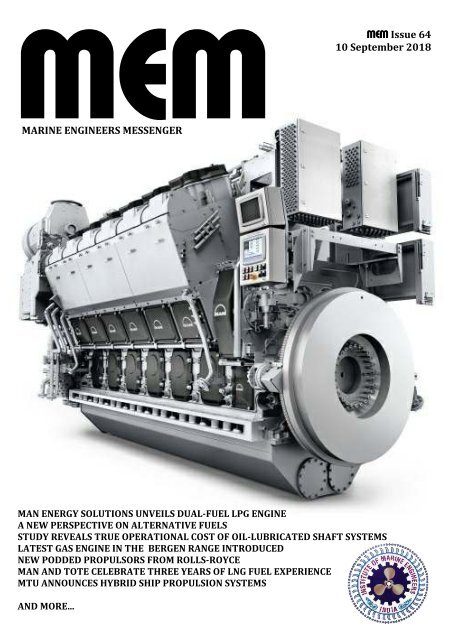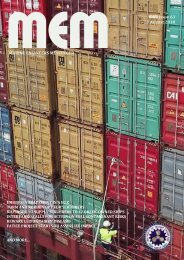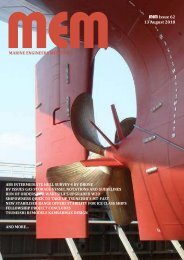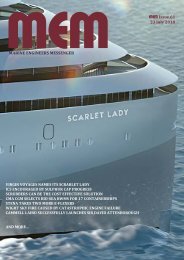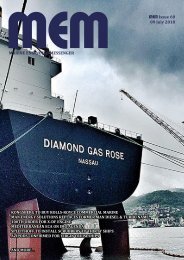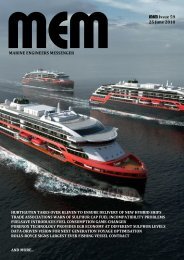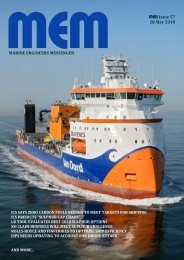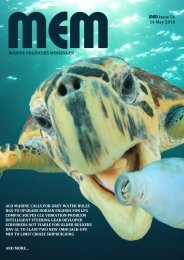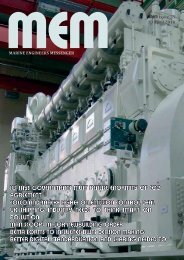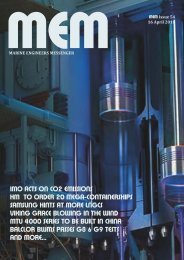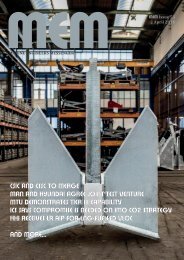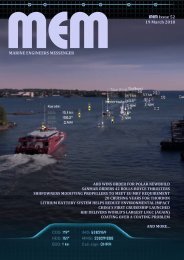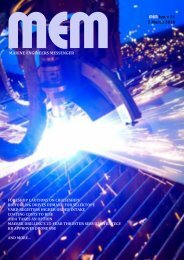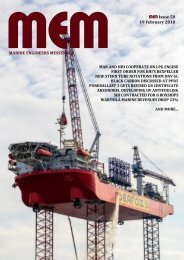MEM64
Marine Engineers Messenger, Vol 3, Issue 64
Marine Engineers Messenger, Vol 3, Issue 64
- No tags were found...
Create successful ePaper yourself
Turn your PDF publications into a flip-book with our unique Google optimized e-Paper software.
MEM<br />
MEM Issue 64<br />
10 September 2018<br />
MARINE ENGINEERS MESSENGER<br />
MAN ENERGY SOLUTIONS UNVEILS DUAL-FUEL LPG ENGINE<br />
A NEW PERSPECTIVE ON ALTERNATIVE FUELS<br />
STUDY REVEALS TRUE OPERATIONAL COST OF OIL-LUBRICATED SHAFT SYSTEMS<br />
LATEST GAS ENGINE IN THE BERGEN RANGE INTRODUCED<br />
NEW PODDED PROPULSORS FROM ROLLS-ROYCE<br />
MAN AND TOTE CELEBRATE THREE YEARS OF LNG FUEL EXPERIENCE<br />
MTU ANNOUNCES HYBRID SHIP PROPULSION SYSTEMS<br />
AND MORE...
MEM<br />
MARINE ENGINEERS MESSENGER<br />
Telegraph<br />
It was not by accident that the organisers of SMM had chosen the motto<br />
"Trends in SMMart Shipping": Digitalisation is one of the key drivers of<br />
the industry, along with environment protection. Indeed many exhibition<br />
stands gave evidence of this, frequently using touchscreens, simulators<br />
and virtual reality goggles to make their innovative technologies more<br />
tangible for visitors.<br />
SMM this year reflected all technical advancements, from lube oil<br />
filters offered by the specialist Bollfilter to the signal horn by Zöllner<br />
through to Furuno's radar system and a ship engine manufactured by the<br />
global market leader, MAN Energy Solutions.<br />
The diversity of exhibitors and visitors along with the amount of new<br />
technical innovations on show - many of which you will read about in this<br />
edition - was indicative of a buoyant industry positive about the near<br />
future.<br />
An event that received plenty of attention was the "Maritime 3D-<br />
Printing Show Area”, something that had never been seen at a maritime<br />
trade fair before. "3D printing is a technology that really catches on, and<br />
our conversations have been going very well," summarised Lina Harms<br />
who represented the Maritime Cluster Norddeutschland, one of the<br />
partners of SMM. SMM was again complemented by high-profile<br />
conferences covering specific topics such as digitalisation (Maritime<br />
Future Summit), environment protection (Global Marine Environmental<br />
Congress), ocean research (Offshore Dialogue) as well as security and<br />
defence (Maritime Security & Defence).<br />
All in all, the general mood has clearly improved, compared with the<br />
year 2016 where the effects of the shipping crisis were still felt very<br />
strongly. For example, as the four-day SMM came to an end, Trond Rolstad<br />
Paulsen, Sales Manager Sensing & Digital Solutions at the Norwegian<br />
technology company Kongsberg, summed up: “It's very good this year,<br />
very well visited, especially on the opening day. People seem to have a<br />
positive mindset and appear willing to invest."<br />
Bernard Meyer, CEO of Meyer Werft, one of the world's leading cruise<br />
ship yards, arrived at a similar conclusion: "It was once again an<br />
outstanding show of the maritime industry."<br />
It is encouraging to see the sector's economic situation being assessed<br />
in much more positive terms than in recent years.<br />
MEM Issue 64<br />
10 September 2018<br />
MEM Contacts:<br />
Editorial:<br />
editorial@mem-online.com<br />
+44 (0) 208 339 6185<br />
+44 (0)777 7668 928<br />
Advertising/Subscriptions:<br />
advertising@mem-online.com<br />
+44 (0) 208 339 6183<br />
Publisher:<br />
publisher@mem-online.com<br />
Website:<br />
www.mem-online.com<br />
MEM is the supporting<br />
marine technical<br />
news resource of<br />
the Institute of<br />
Marine Engineers<br />
(India)<br />
The information published in MEM does<br />
not necessarily represent the views of<br />
the publisher or the IME (I). The<br />
publisher makes no representation or<br />
warranty as to the accuracy or<br />
correctness of the information or<br />
accepts responsibility for any loss,<br />
damage or other liability pertaining to<br />
the information published in this<br />
newsletter.<br />
©2018 Seaborne Communications Ltd<br />
3
FURL<br />
A NEW PERSPECTIVE ON ALTERNATIVE FUELS<br />
The rapidly approaching 2020 fuel<br />
sulphur cap and newly announced<br />
IMO greenhouse gas (GHG)<br />
reduction strategy have put the<br />
spotlight onto alternative fuels for<br />
shipping. DNV GL’s new AFI<br />
platform offers a comprehensive<br />
and continually updated overview<br />
of alternative fuel projects,<br />
bunkering infrastructure, suppliers,<br />
and technologies.<br />
“Alternative fuels and<br />
propulsion technologies should be<br />
on the radar of every shipowner,<br />
especially those in the market for a<br />
newbuilding in the near future,”<br />
said Knut Ørbeck-Nilssen, CEO of<br />
DNV GL – Maritime. “The AFI<br />
platform has been developed to<br />
provide a clear picture not only of<br />
the fuels and the surrounding<br />
infrastructure, but to build links<br />
between suppliers and owners and<br />
charterers. The knowledge<br />
collected on the platform is<br />
expanding into a 360-degree view<br />
of the sector, allowing all<br />
stakeholders to make informed<br />
decisions.”<br />
The AFI platform builds on<br />
DNV GL’s LNGi portal, but with an<br />
expanded focus that covers LNG,<br />
LPG and methanol, as well as<br />
emission reducing technologies<br />
such as scrubbers and batteries.<br />
The platform consolidates a<br />
wealth of detailed technical<br />
information on these fuels and<br />
technologies, including their<br />
bunkering infrastructure, and<br />
examines their capabilities and<br />
limitations, as well as giving<br />
practical insights into their<br />
implementation and operation.<br />
ALFA LAVAL ADDRESSES 2020 FUEL CHALLENGES THROUGH<br />
Alfa Laval claims a unique depth of expertise in<br />
marine fuel treatment, encompassing not just fuel<br />
separators but the whole chain from bunker tank to<br />
engine.<br />
As onboard operations change in<br />
response to fuel sulphur regulations,<br />
the company is optimising and<br />
updating the technologies in its<br />
portfolio to meet the new challenges.<br />
The result, says the company, will be<br />
improved engine protection and<br />
increased energy efficiency, despite<br />
more varied and less predictable<br />
fuels.<br />
With the global sulphur cap taking in effect in 2020,<br />
onboard fuel handling will become more complicated<br />
than ever before. “There will be many options for<br />
compliance and every vessel will have to choose the<br />
route that makes most sense for their operation,”<br />
explained Serdar Sengun (pictured), Global Sales<br />
Manager Marine Separation, Alfa Laval. “No matter<br />
what customers choose, it will have dramatic<br />
implications for the fuel line. But Alfa Laval is taking a<br />
complete and forward-thinking approach to fuel line<br />
optimisation.”<br />
A number of new fuels and fuel blends have<br />
already entered the market, and more are likely to<br />
appear once the global sulphur cap is in place. For<br />
many fleets, 2020 will also mean going from<br />
existing single-fuel systems to multi-fuel<br />
operations. If not managed properly, using<br />
multiple fuel oils can result in a variety of<br />
issues – especially when the fuels are<br />
unfamiliar. The problems can range from<br />
clogged fuel systems to, in the worst case,<br />
engine stoppage.<br />
“As refineries recalibrate for lower sulphur<br />
content, we also anticipate a continued<br />
increase in the proportion of cat fines in marine fuel<br />
oils,” added Sengun. “Already, we have seen a huge<br />
rise in cat fines, which cause major problems if not<br />
separated from the fuel before it reaches the engine.”<br />
“Matching the separator feed to engine load is<br />
critical to achieving the highest efficiency and engine<br />
protection, as field tests have clearly shown,” said<br />
Sengun. “After separation, matching the fuel to the<br />
maker’s specifications is critical for the engine, its<br />
injection systems and the safety of the vessel. All of<br />
these processes have to occur smoothly and safely,<br />
no matter what fuel is used.”<br />
4
LUBRICANTS<br />
ENGINE PROTECTION BEYOND 2020, ACCORDING TO SHELL<br />
Marine lubricant choices to<br />
address International Maritime<br />
Organization restrictions on the<br />
fuels used by ships from 2020<br />
must be based on verifiable<br />
cylinder oil performance data and<br />
engine testing to cover all<br />
operating conditions, according to<br />
the new General Manager of Shell<br />
Marine, Joris Van Brussel.<br />
“Recent months have seen some<br />
movement by mainstream<br />
shipowners towards exhaust gas<br />
scrubbing to meet the 2020<br />
marine fuel sulphur cap,” said<br />
Joris. “These customers will<br />
continue using high sulphur heavy<br />
fuel oils with two stroke engines,<br />
and demand lubes that are proven<br />
to protect cylinders against cold<br />
corrosion under extreme stress,<br />
such as Shell Alexia S6 or the<br />
higher BN Shell Alexia 140.<br />
“However, with just over a year<br />
to go before the new restrictions<br />
enter into force, a significant part<br />
of the market will shift to fuels<br />
with less than 0.5% sulphur,<br />
where other cylinder oil<br />
formulations with a lower BN<br />
number is expected to deliver<br />
optimum performance.<br />
“The two-stroke product<br />
portfolio for 2020 is largely in<br />
place, but we expect that there will<br />
be a requirement for significant<br />
volumes of higher BN cylinder oils<br />
to be replaced by BN40 or BN70<br />
grades.”<br />
STUDY REVEALS TRUE OPERATIONAL COST OF OIL-LUBRICATED SHAFT SYSTEMS<br />
Thordon Bearings has published a study highlighting<br />
the commercial and environmental benefits of<br />
seawater-lubricated propeller shaft bearing<br />
arrangements, indicating that shipowners can make<br />
substantial operational savings by giving up the<br />
outdated oil lubricated shaft.<br />
The study, the findings of<br />
which were presented for the<br />
first time during the SMM 2018<br />
trade fair in Hamburg, Germany,<br />
was carried out in response to the<br />
increase in oil and oil-based<br />
Environmentally Acceptable<br />
Lubricant (EAL) lubricated<br />
sterntube bearing failures, which<br />
are placing an additional and<br />
unnecessary financial burden on shipowners.<br />
Despite the introduction of legislation to reduce<br />
shipping’s impact on the oceans, together with<br />
shipowners’ ever-present need to reduce operational<br />
costs, the majority of commercial ocean-going vessels<br />
continue to use a system that is increasing risk and is<br />
costly to operate.<br />
“It is quite staggering that over 95% of all new<br />
commercial ships continue to be built with oil<br />
lubricated propeller shafts – a system that is not only<br />
operationally expensive but environmentally<br />
questionable,” said Craig Carter, Thordon Bearing’s<br />
Director of Marketing and Customer Service.<br />
“Our Future, Our Ocean paper presents the case<br />
for water lubrication to shipowners and shipbuilders<br />
as a commercially and technically viable way of<br />
increasing profits while achieving corporate<br />
sustainability goals.”<br />
The 14-page document explains that while the low<br />
capital expenditure of an oillubricated<br />
system is an obvious<br />
attraction, any financial advantage<br />
is completely lost once the vessel<br />
enters the water. This, cites<br />
Thordon Bearings, is due to the<br />
costs associated with purchasing<br />
lubricating oils, the regular<br />
maintenance and unscheduled<br />
drydockings required to repair or<br />
replace faulty shaft seals.<br />
While emergency seal repairs alone can cost<br />
anywhere from US$150,000 to US$300,000,<br />
excluding drydock costs, the paper furthers that the<br />
constant topping up of an oil-lubricated system,<br />
combined with the regularity of aft seal failure, can<br />
cost shipowners in excess of US$6.5 billion over a<br />
twenty-five-year period.<br />
The paper reveals that for a typical single screw<br />
bulk carrier turning a 650mm shaft, the total cost of<br />
operating an oil-lubricated system over 25 years<br />
(including capital investment) is US$605,925 against<br />
$370,000 for a seawater-lubricated arrangement.<br />
ADVERTISE HERE AND REACH OUT TO AN MEM COMMUNITY OF<br />
MORE THAN 18000 MARINE ENGINEERING PROFESSIONALS<br />
For more information about our cost-effective advertising rates<br />
Email: advertising@mem-online.com or visit www.mem-online.com<br />
5
MAIN ENGINES<br />
MAN BENEFITS FROM CRUISE ORDER SURGE<br />
MAN Energy Solutions says that it is currently<br />
experiencing a record order-intake within its cruise<br />
business.<br />
The company reports that, in the first eight months<br />
of 2018, it has won orders to supply seven new cruise<br />
ships with engines plus exhaust-gas-treatment<br />
systems – with a cumulative value close to a threedigit<br />
million EUR amount.<br />
The orders total almost 300 MW of installed power<br />
for cruise ships ranging in size from 50,000 to<br />
approximately 140,000 gross tons, and running on fuel<br />
types from HFO to LNG. Delivery is scheduled from<br />
end-2019 to 2022.<br />
Sokrates Tolgos – Head of Cruise Sales & Tendering,<br />
MAN Energy Solutions – said: “These orders<br />
demonstrate in a nutshell MAN’s capability to provide<br />
state-of-the-art, efficient engine technology along with<br />
emission-reducing solution packages regardless of the<br />
fuel type preferred by the customer.”<br />
The engine technology and emission-reduction<br />
concepts ordered cover a wide range of MAN’s<br />
solution portfolio for the marine business: from type<br />
NEW METHANOL ENGINE HITS THE MARINE MARKET<br />
32/44CR engines with fully electronic common-rail<br />
injection systems capable of operating on HFO, to<br />
dual-fuel type 51/60DF engines that enable the use<br />
of both LNG and oil-based fuels. The orders also<br />
include MAN’s proprietary NOx-reducing SCR system<br />
as well as closed-loop-type wet scrubbers sourced<br />
from MAN partners.<br />
Within the frame of the GreenPilot<br />
project, Gothenburg-based<br />
ScandiNAOS AB has developed<br />
marine methanol engine concepts.<br />
The spark ignited methanol engine<br />
that has been installed and tested in<br />
the Swedish Pilot boat ‘GreenPilot’<br />
has now been followed by a<br />
compression ignited methanol<br />
engine.<br />
The GreenPilot project is led<br />
and initiated by Swedish Maritime<br />
Technology Forum, part of RISE<br />
Research Institutes of<br />
Sweden. The first delivery<br />
to client of the new engine<br />
for full scale operation is<br />
scheduled for January<br />
2019. Both engines are<br />
based on Scania 13L<br />
marine diesel engine and<br />
can be delivered either for<br />
variable speed<br />
(propulsion) or single<br />
speed genset applications.<br />
ScandiNAOS led the design<br />
work for the conversion of Stena<br />
Germanica to methanol operation<br />
in 2015 and has provided the<br />
methanol engine and<br />
modifications of the onboard<br />
system for the GreenPilot project.<br />
Partners in the GreenPilot<br />
project are ScandiNAOS, Swedish<br />
Maritime Technology Forum part<br />
of RISE Research Institutes of<br />
Sweden, SSPA, the Swedish<br />
Transport Agency and the<br />
Swedish Maritime Administration.<br />
Co-financers are the Swedish<br />
Transport Agency, the Swedish<br />
Maritime Administration and<br />
Methanol Institute.<br />
6
MAN ENERGY SOLUTIONS UNVEILS DUAL-FUEL LPG ENGINE<br />
MAN Energy Solutions has<br />
revealed its latest two-stroke<br />
engine type, a dual-fuel MAN B&W<br />
ME-LGIP engine designed for LPG<br />
running.<br />
MAN Energy Solutions’ Thomas<br />
Knudsen, Head of the two-stroke<br />
business unit, said: “The ME-LGIP<br />
builds on the success we have had<br />
with our ME-GI and ME-LGI dualfuel<br />
engines, which have won over<br />
250 orders since their<br />
introduction to the market.<br />
Employing essentially the same<br />
proven technology, we can now<br />
add LPG to the expanding list of<br />
non-HFO and alternative fuels that<br />
our two-stroke technology can<br />
exploit.”<br />
Interest in using LPG as a fuel,<br />
within and outside of the LPG<br />
carrier segment, is growing due to<br />
its sulphur-free character,<br />
widespread availability and ease of<br />
bunkering. In gas mode, the ME-<br />
LGIP engine operates on just 3%<br />
pilot oil and down to 10% load.<br />
Ultimately, we expect the engine to<br />
operate without the need for pilot<br />
oil.”<br />
Bjarne Foldager, vice president<br />
sales & promotion – two-stroke<br />
business unit, said: ”The ME-LGIP<br />
can also burn liquid volatile<br />
organic compou nds, a deliberate<br />
move on our part since the IMO<br />
will inevitably turn its focus<br />
towards the reduction of volatile<br />
organic compounds in the future.<br />
Accordingly, we view the ME-LGIP<br />
as also ideally suited to the<br />
propulsion of shuttle tankers and<br />
very large crude carriers.”<br />
The Diesel principle provides<br />
the ME-LGIP engine with high<br />
operational stability and efficiency,<br />
including during load changes and<br />
fuel change-over, while defining<br />
properties such as a stable changeover<br />
from one fuel type to another<br />
with no fuel-penalties are<br />
maintained. The negligible gas slip<br />
of the ME-LGIP engine makes it the<br />
most environmentally friendly,<br />
two-stroke technology available.<br />
MAN Energy Solutions also<br />
reports that the ME-LGIP engine<br />
has experienced an up to 18%<br />
reduction in CO2 and circa 90%<br />
reduction in particulate matter<br />
when running on LPG, compared<br />
with HFO.<br />
MAN Energy Solutions won the<br />
first order for the new engine back<br />
in March 2018 when Hanjin Heavy<br />
Industries announced that it would<br />
construct two VLGCs (very large<br />
gas carriers) in its Philippines<br />
Facilities for EXMAR, the Belgian<br />
integrated gas shipping company.<br />
The 80,000m3 newbuildings will<br />
each be powered by an individual<br />
MAN B&W 6G60ME-LGIP Mk9.5<br />
engine.<br />
LPG was chosen as a fuel option<br />
for the VLGCs to comply with the<br />
new IMO sulphur-emission<br />
legislation due to enter force in<br />
2020. Engine delivery to the yard<br />
has been scheduled for December<br />
2019 and, upon construction, the<br />
carriers will be chartered by<br />
Statoil.<br />
The ME-LGI (-Liquid Gas<br />
Injection) concept can be applied<br />
to all MAN Energy Solutions lowspeed<br />
engines from 50-bore and<br />
up, either ordered as an original<br />
unit or through retrofitting.<br />
With the ME-LGIP engine, LPG<br />
joins the list of liquid,<br />
environmentally-friendly fuels that<br />
can power MAN Energy Solutions’<br />
portfolio of two-stroke, dual-fuel<br />
engines, which are available from<br />
all licensees. MAN Energy<br />
Solutions further reports that it<br />
expects ME-LGIP installation<br />
aboard merchant vessels to be<br />
extremely competitive price-wise,<br />
compared to other, dual-fuelburning<br />
engine types.<br />
LPG’s future as a viable fuel for<br />
general marine transportation<br />
looks promising as it will not<br />
require as large an investment in<br />
infrastructure – such as bunkering<br />
facilities – in contrast to other,<br />
gaseous fuels. As a widespread<br />
energy source, availability is high<br />
and LPG is easier to store and<br />
handle, compared with cryogenic<br />
gaseous fuels.<br />
Furthermore, LPG is<br />
traditionally a cheaper fuel than<br />
MGO yet delivers the same<br />
performance and efficiency.<br />
Importantly, the ability to use LPG<br />
cargo as a supplemental fuel<br />
source provides significant cost<br />
savings for LPGC owners or<br />
charterers, including reduced time<br />
and fees for fuel bunkering.<br />
Accordingly, MAN Energy<br />
Solutions expects a strong demand<br />
for the ME-LGIP engine from very<br />
large gas carriers (VLGCs) and<br />
coastal vessels from its<br />
introduction.<br />
With a new injection concept,<br />
initially developed for methanol,<br />
the ME-LGI concept greatly<br />
expands the company’s dual-fuel<br />
portfolio and enables the<br />
exploitation of more low-flashpoint<br />
fuels such as ethanol,<br />
dimethyl ether and, now, LPG.<br />
7
LATEST GAS ENGINE IN THE BERGEN RANGE INTRODUCED<br />
Rolls-Royce has launched<br />
its latest in a series of<br />
liquefied natural gas<br />
(LNG) fuelled<br />
marine engines.<br />
The Bergen<br />
B36:45 model is<br />
designed in<br />
accordance with<br />
the Rolls-Royce<br />
philosophy of a<br />
common platform<br />
for all fuel options<br />
and applications,<br />
and can be<br />
configured to meet<br />
the specific engine<br />
requirements of<br />
customers.<br />
Power output of the<br />
LNG-fuelled B36:45 engine is<br />
identical to that of the liquidfuelled<br />
B33:45 at 600kW per<br />
cylinder at 750 rpm. Specific<br />
energy consumption is a low<br />
7300kj/kWh mechanical ISO<br />
including two engine driven<br />
pumps; specific lubricating oil<br />
consumption is less than<br />
0.4g/kWh.<br />
The B36:45 is available in six,<br />
eight and nine-cylinder in-line<br />
configurations. A V-12 version is<br />
now in development, which will<br />
be followed by a 20-cylinder V-<br />
engine for very high-power<br />
applications.<br />
The proven lean-burn Otto<br />
cycle combustion B36:45<br />
technology has been developed<br />
during Bergen Engines’ extensive<br />
experience with LNG-fuelled<br />
engines so that methane slip,<br />
which contributes to greenhouse<br />
gas emissions, has been<br />
minimised.<br />
Kjell Harloff, Rolls-Royce<br />
Commercial Marine, Senior Vice<br />
President – Engines, said: “This<br />
new engine builds on the success<br />
of the Bergen B35:40-series<br />
engine and offers a variety of new<br />
benefits to our customers,<br />
including rapid response to<br />
changes in load and speed, high<br />
reliability and clean burning.<br />
“This makes the B36:45 ideally<br />
suited for mechanical ship<br />
propulsion installations, driving<br />
either controllable or fixed-pitch<br />
propellers. The engine is equally<br />
at home operating at constant<br />
speed driving alternators in gaselectric<br />
propulsion or auxiliary<br />
power generation systems.”<br />
The latest Bergen gas engines<br />
are able to achieve up to 22<br />
percent lower Green House Gas<br />
(GHG) emissions than the<br />
equivalent diesel-fuelled version.<br />
“As most LNG is sulphur-free<br />
fuel, sulphur oxides (SOx) and<br />
particulate matter emissions are<br />
virtually eliminated, while<br />
emissions of nitrogen oxide (NOx)<br />
are reduced by over 90 percent<br />
compared to an equivalent diesel<br />
engine. This means that the<br />
Bergen B36:45 is able to meet<br />
IMO Tier III and EPA Tier 3<br />
emission levels without the need<br />
for additional selective catalytic<br />
reduction (SCR) systems.<br />
In the case of the new B36:45,<br />
the main structural components<br />
are the same as those used in the<br />
B33:45-series liquid fuel engines.<br />
The crankcase, common to all<br />
engine types, incorporates all air<br />
and oil galleries, minimising<br />
external pipework and ensuring<br />
stiffness and operational safety.<br />
Individual cylinder heads<br />
and three-piece connecting rods<br />
allow the complete head, liner,<br />
piston and upper conrod to be<br />
withdrawn for overhaul and<br />
replaced, as an assembly, without<br />
disturbing the engine bottom end.<br />
Leif-Arne Skarbø, Chief<br />
Technology Officer at Rolls-Royce<br />
Power Systems, Bergen Engines,<br />
added: “Other benefits for end<br />
users and shipbuilders arising<br />
from this modular approach are<br />
that the product is configurable,<br />
and production is simplified,<br />
resulting in a highly competitive<br />
cost per kW and straightforward<br />
installation and maintenance.”<br />
For the gas version, different<br />
liners, pistons and heads are<br />
employed, giving a 30mm<br />
increase in cylinder bore<br />
compared with the existing, wellproven,<br />
liquid-fuelled B33:45.<br />
The stroke remains unchanged, at<br />
45cm. Other changes involve the<br />
fuel system and injectors, which<br />
are Bergen Engines’ own design<br />
and make for reliable operation<br />
with gaseous fuels. The robust<br />
variable valve timing system<br />
allows optimum response to load<br />
changes, regardless of the grade<br />
of fuel.<br />
8
PROPULSION<br />
NEW PODDED PROPULSORS FROM ROLLS-ROYCE<br />
Rolls-Royce has unveiled<br />
ELegance – a completely<br />
new podded propulsion<br />
system designed to meet<br />
market demand for smaller,<br />
more compact units.<br />
The ELegance pods –<br />
one with an open propeller,<br />
the other ducted –<br />
complement and complete<br />
the company’s existing<br />
portfolio of mechanical and<br />
electric propulsion<br />
systems.<br />
Per Nahnfeldt, General<br />
Manager Product – Electric<br />
Propulsion, Rolls-Royce,<br />
said: “For many years we<br />
have recognised the gap in<br />
the propulsion market for<br />
smaller pods, including iceclass,<br />
in the 1.5MW to 7MW<br />
power range. These new<br />
pods – based on our Permanent<br />
Magnet technology – complement<br />
our broad product portfolio and<br />
sit well with our range of<br />
frequency drives and electrical<br />
systems. We can now provide a<br />
complete fully electric propulsion<br />
package.”<br />
The use of permanent magnet<br />
(PM) motors in podded<br />
propulsion provides a high motor<br />
efficiency over all speed ranges.<br />
Their use also results in a pod that<br />
optimises the trade-off between<br />
electric, mechanical and<br />
hydrodynamic efficiency.<br />
Andreas Seth, Rolls-Royce SVP<br />
Electrical, Automation & Control –<br />
Marine, said: “Our PM technology<br />
and know-how has become a<br />
game changer for many of our<br />
product innovations. In this case<br />
the PM technology and the motor<br />
fitting in the casing have allowed<br />
us to create a sleek, slimline pod,<br />
which adds significantly to<br />
hydrodynamic efficiency.”<br />
Nahnfeldt added: “The pods<br />
feature a ‘twin tail’ concept to<br />
further improve efficiency while<br />
significantly reducing cavitationinduced<br />
noise and vibration. A<br />
new integrated hull fitting<br />
interface also allows a compact<br />
head-box to be used, which<br />
minimises drag and further<br />
improves hull efficiency. This also<br />
allows the height and tilt of the<br />
pod to be adjusted, allowing<br />
operators to select the optimum<br />
propeller size for the vessel.”<br />
The 1A Super and Polar Code 6<br />
ice class pods have also been<br />
designed with installation and<br />
maintenance simplicity in mind.<br />
For example, should the pods<br />
need to be replaced they can<br />
be lifted and mounted in<br />
water. This builds on the<br />
experience from the<br />
underwater mounting of<br />
Rolls-Royce azimuthing<br />
propulsors and provides a<br />
means for replacement of the<br />
complete units, including the<br />
steering gear, for ease of<br />
maintenance and service in,<br />
as well as out of, drydock.<br />
“Both pushing and pulling<br />
pods have been designed with<br />
several layers of redundancy<br />
on critical and hard-to-reach<br />
components, with service<br />
points positioned for easy<br />
access,” said Nahnfeldt.<br />
Maintenance is optimised<br />
by way of fewer moving parts<br />
within the below-thewaterline<br />
housing and the<br />
only components that require drydocking<br />
service are the pod’s<br />
bearings and seals. These<br />
however have a life expectancy of<br />
ten years or more before they<br />
need replacing.<br />
“This reduced maintenance<br />
requirement correlates directly to<br />
low life-cycle costs,” said<br />
Nahnfeldt, adding that with a<br />
focus on environmental safe<br />
operation, the robust sealing<br />
solution that has been selected<br />
has no oil-to-sea interfaces.<br />
Should system oil leak at all, it is<br />
fed into a dedicated sump<br />
connected to the ship’s bilge<br />
system.<br />
Rolls-Royce is now building a<br />
4.6MW ELegance pod at its Rauma<br />
facility in Finland and is in<br />
discussions with shipowners to<br />
install the pod in a pilot project.<br />
MARINE ENGINEERS MESSENGER<br />
SHIP TECHNOLOGY NEWS TO 8544 DECISION MAKERS<br />
EVERY TWO WEEKS<br />
Click here for more information about our favourable advertising rates or<br />
email: advertising@mem-online.com<br />
9
MTU ANNOUNCES HYBRID SHIP PROPULSION SYSTEMS<br />
As of 2020, Rolls-Royce will launch a range of<br />
completely integrated MTU hybrid ship propulsion<br />
systems onto the market. The propulsion systems<br />
will also be made available for yachts, work boats,<br />
ferries and patrol boats in a power range extending<br />
from around 1,000kW to 4,000kW per powertrain.<br />
Rolls-Royce is planning to test a new MTU hybrid<br />
system incorporating Series 2000 engines in 2019.<br />
“The combination of diesel engines and electric<br />
motors, in addition to batteries, will offer our<br />
customers significant benefits in a variety of marine “This is something we are quite capable of doing as<br />
applications. The most important being efficiency, a result of decades of experience in system integration<br />
environmental compatibility and the flexibility of the and with the aid of our Blue Vision New Generation<br />
propulsion system,” said Knut Müller, Head of the Hybrid automation system,” he added.<br />
Marine and Government Business at MTU.<br />
The systems will be offered in a variety of power<br />
Rolls-Royce will be offering complete hybrid ranges to suit individual customer requirements. As of<br />
propulsion systems from MTU for ships, consisting of 2020, systems incorporating MTU Series 2000 engines<br />
MTU internal combustion engines, electric drive combined with one or two electric motors per power<br />
modules, transmission systems, batteries, monitoring train each with 150 kW of electrical output, will be<br />
and control systems, in addition to other electronic launched on the market. As of 2021, MTU will then<br />
components. “We will provide integrated systems to extend its portfolio with the addition of hybrid systems<br />
our customers, together with an appropriate selection based on the power delivered by MTU Series 4000<br />
of propulsion modes that are easy to operate,” Müller engines and as many as four electric motors.<br />
explained.<br />
EMISSIONS<br />
PURE SOX SECURES FUTURE FLEXIBILITY<br />
According to Alfa Laval,<br />
SOx compliance and the<br />
approaching global<br />
sulphur cap are among<br />
the marine industry’s<br />
most pressing concerns.<br />
The company says it is<br />
not only working to<br />
meet today’s scrubber<br />
demand, but also<br />
securing long-term<br />
peace of mind for those<br />
who invest in its PureSOx systems.<br />
“Alfa Laval’s focus is securing the<br />
compliance of our customers, both<br />
CO2 CHALLENGE MOVES AHEAD<br />
The CO2 Challenge has now moved<br />
into the second stage, the project<br />
partners Cargill, Rainmaking and<br />
DNV GL announced. The CO2<br />
Challenge looks to find and scale<br />
technologies capable of reducing<br />
vessel greenhouse gas emissions<br />
by 10%.<br />
Since the project was<br />
announced in June 2018, the CO2<br />
Challenge has received some 70<br />
applicants from 20 different<br />
today and for the future,” said<br />
Erik Haveman, Sales Director,<br />
Exhaust Gas Cleaning. “Naturally<br />
we want to meet the<br />
demand that currently<br />
exists. But we also want<br />
to ensure that our<br />
customers are a step<br />
ahead, so that they can be<br />
confident in meeting<br />
tomorrow’s challenges.<br />
“Many customers today are<br />
purchasing open-loop PureSOx<br />
systems,” said Haveman. “But there<br />
is the possibility of stricter water<br />
countries; the scouting process<br />
uncovered a further 68 start-ups.<br />
The project team, which<br />
consists of representatives from<br />
DNV GL, Cargill and Rainmaking,<br />
are in the process of interviewing<br />
the applicants.<br />
The CO2 Challenge has received<br />
a wide variety of technical<br />
applications, including wind<br />
propulsion, engine optimization,<br />
discharge regulations in the future.<br />
By preparing all open-loop<br />
deliveries for easy upgrading to a<br />
hybrid system, we give PureSOx<br />
customers room to adapt if tougher<br />
laws appear.”<br />
Going forward, PureSOx can be<br />
designed to handle fuels with<br />
sulphur contents above 3.5%. This<br />
will be useful if higher-sulphur fuels<br />
are offered to the market, for<br />
example as a result of changing<br />
refinery output after 2020.<br />
digital, air lubrication, hull<br />
optimisation and more.<br />
“DNV GL is very proud to be<br />
working with a partner like Cargill,<br />
who are demonstrating their<br />
vision for more efficient and<br />
environmentally responsibility<br />
maritime operations,” said Trond<br />
Hodne, DNV GL - Maritime Sales<br />
and Marketing Director.<br />
10
STABILISERS<br />
SKF OFFERS STABILITY TO EXPEDITION VESSELS<br />
SKF has won a €2.25 million order to deliver two<br />
pairs of retractable fin stabilizers, including novel<br />
dynamic stabilizer covers, for a 182.9m research<br />
expedition vessel currently being fitted out at a<br />
Norwegian shipyard.<br />
SKF will manufacture and deliver two pairs of<br />
retractable fin stabilisers for the control of the<br />
vessel’s rolling motions, along with its innovative<br />
new SKF Dynamic Stabiliser Cover system which has<br />
been designed to reduce drag at the fin box openings<br />
and reduce fuel consumption for the vessel by more<br />
than 1%.<br />
SKF's Type Z stabiliser is designed so that the fin<br />
can be fully retracted and housed entirely within a<br />
vessel without any hull protrusion. , These stabiliser<br />
systems are simple to operate, the associated control<br />
system being fully adaptive to the ship’s speed, sea<br />
state and vessel roll motion, with selectable single or<br />
twin fin deployment of ±60° working angle in zero<br />
speed mode.<br />
The SKF Type Z stabiliser is accompanied by its<br />
innovative SKF Dynamic Stabiliser Cover, the design<br />
of which comprises of two specially shaped air<br />
cushions, fitted to the top and bottom of the fin box<br />
with small steel rails. In normal operation, the<br />
cushions are inflated using compressed air from the<br />
vessel’s existing pneumatic systems. Inflated, the<br />
cushions form a smooth, streamlined cover over the<br />
fin box opening to achieve a significant reduction in<br />
drag.<br />
When the stabiliser fin is to be extended or<br />
retracted, air is released from the cushions which are<br />
then deflated by the water pressure outside the hull,<br />
creating room for the fin’s movement.<br />
When deployment or housing is complete, the<br />
cushions can be re-inflated. Control of the covers is<br />
fully integrated into the stabiliser fin control<br />
systems, requiring no additional action by the crew.<br />
Delivery of the fin stabilisers, dynamic stabiliser<br />
covers and associated control systems is scheduled<br />
for the beginning of September 2018.<br />
BEARINGS<br />
THORDON SEAWATER LUBRICATED BEARINGS GUARANTEED FOR A LIFETIME<br />
Thordon Bearings is offering its<br />
award-winning COMPAC seawater<br />
lubricated propeller shaft bearing<br />
system with a lifetime bearing wear<br />
life guarantee.<br />
To date, the COMPAC bearing<br />
has been offered with a 15-year<br />
wear life guarantee, but<br />
with the development<br />
announced today at<br />
the SMM 2018 trade<br />
show in Hamburg,<br />
Germany, Thordon,<br />
the global leader in<br />
seawater lubricated<br />
propeller shaft bearings,<br />
is guaranteeing that its<br />
tough polymer bearings will not<br />
need to be replaced throughout a<br />
vessel’s operational life.<br />
The extended wear life of a<br />
component critical to vessel<br />
performance is based on an<br />
extensive study of the performance<br />
data of the 550-plus COMPAC shaft<br />
bearings in operation on<br />
commercial vessels, dating back<br />
more than 25 years.<br />
Thordon Bearings’ President and<br />
CEO, Terry McGowan, said: “After<br />
evaluating the performance and<br />
operational data of the ocean-going<br />
merchant vessels that operate<br />
COMPAC seawater lubricated<br />
bearings we<br />
found that if<br />
the<br />
environme<br />
nt was<br />
controlled -<br />
ensuring an<br />
adequate supply<br />
of clean water consistently<br />
delivered to the shaft bearings – the<br />
COMPAC bearing wear was<br />
minimal. Environmental protection<br />
is of course high on the list of<br />
priorities for ship owners, but<br />
system reliability, reduced<br />
operational expenditure and<br />
maintenance are other key factors<br />
influencing the purchasing<br />
decision.”<br />
“We believe our system meets<br />
these commercial ship owner<br />
priorities, and this is why we are<br />
pleased to now offer our COMPAC<br />
bearings with a lifetime guarantee.<br />
With the announcement today, we<br />
are taking the seawater lubricated<br />
propeller shaft to the next level.”<br />
The COMPAC bearing is<br />
guaranteed to meet Classification<br />
Society propeller shaft bearing wear<br />
specifications for the lifetime of the<br />
vessel or Thordon Bearings will<br />
supply new bearings free of charge.<br />
According to VesselsValue.com, the<br />
average merchant ship lifespan is<br />
25 years.<br />
The guarantee is subject to prior<br />
approval by Thordon Bearings and<br />
limited to the supply of replacement<br />
bearing(s). All operators of<br />
commercial tonnage operating with<br />
>300mm diameter shafts can<br />
benefit from the guarantee,<br />
although the complete COMPAC<br />
system must be specified.<br />
11
COATINGS<br />
DISSOLVABLE PACKAGING<br />
FOR SELEKTOPE AGENT<br />
Swedish bio-tech innovator I-<br />
Tech AB has developed a new<br />
‘drop-in, dust-free’ dissolvable<br />
packaging system to enhance<br />
the way its antifouling active<br />
agent Selektope is added to<br />
marine coatings during the<br />
manufacturing process.<br />
The expanded polystyrene<br />
(EPS) container, which can be<br />
added to paint without being<br />
opened, fully dissolves almost<br />
instantaneously without leaving<br />
any traces in the coating system.<br />
This innovative packaging<br />
therefore allows for the dust<br />
free charging of 100% Selektope<br />
powder material to a liquid<br />
paint batch, eliminating dust<br />
formation completely. It also<br />
allows the paint manufacturer<br />
to make optimal use of available<br />
Selektope and improves safety<br />
in the paint processing plant.<br />
Each EPS container is<br />
supplied within a CurTec HDPE<br />
screw lid jar with locking<br />
mechanism making it durable<br />
with improved impact<br />
resistance for transport. The<br />
complete EPS container system<br />
can hold 300-800g of<br />
medetomidine (the chemical<br />
name for Selektope) as a dry<br />
powder within a very low<br />
weight (18g) EPS container.<br />
BALLASTING<br />
PUREBALLAST 3 EX DECKHOUSE SOLUTION MEETS<br />
PRODUCT TANKER NEEDS<br />
A new Alfa Laval<br />
PureBallast 3 Ex<br />
deckhouse<br />
solution has<br />
been validated<br />
for product<br />
tankers with<br />
Framo ballast<br />
pumps. The<br />
solution allows<br />
Alfa Laval<br />
PureBallast 3 Ex<br />
to be installed on deck – without<br />
any changes to the ballast pumping<br />
system on board.<br />
Modern product tankers use<br />
submersible ballast pumps to<br />
eliminate the ballast pump room<br />
and create more space for cargo.<br />
This means their ballast water<br />
treatment systems must often be<br />
installed in a deckhouse. However,<br />
the filter backflushing sequence<br />
may require water pressure in<br />
excess of available pressures from<br />
today’s market-standard ballast<br />
pump design.<br />
“The situation is a Catch-22 for<br />
owners of product tankers, who<br />
may have to alter a functioning<br />
AQUARIUS BWMS GAINS USCG APPROVAL<br />
pumping system to support ballast<br />
water treatment,” said Anders<br />
Lindmark, Head of Alfa Laval<br />
PureBallast. “Working together, the<br />
technical teams for Framo pumping<br />
systems and Alfa Laval ballast<br />
water treatment systems have<br />
developed a deckhouse solution<br />
that removes this headache.”<br />
The new deckhouse solution<br />
incorporates a booster pump unit<br />
into the PureBallast 3 Ex system, as<br />
well as other modifications to<br />
increase backflushing pressure. The<br />
modifications ensure that sufficient<br />
backflushing pressure will be<br />
generated by the ballast water<br />
treatment system itself.<br />
Wärtsilä’s Aquarius BWMS has been<br />
granted Type Approval by USCG. This<br />
approval verifies that the product has<br />
met the specified regulatory, technical,<br />
and safety requirements, and<br />
represents an endorsement of its<br />
design and efficiency principles.<br />
As part of the approval process, the<br />
Aquarius EC (Electro-Chlorination)<br />
system’s technology underwent an extensive land<br />
and sea test programme, during which it delivered<br />
exceptional performance.<br />
“We are naturally delighted that following a stringent review and<br />
investigation process, the USCG has granted Type Approval. This follows<br />
similar approval given by the IMO in 2013. Since Wärtsilä offers both EC<br />
and UV (Ultra-Violet) technologies, we are uniquely able to provide<br />
impartial advice to owners and operators regarding the most suitable<br />
system for their particular needs,” said Timo Koponen, Vice President,<br />
Processing Solutions, Wärtsilä Marine Solutions.<br />
The Aquarius EC is capable of treating ballast water volumes from<br />
250m3/hour to 4000m3/hour. It utilises a simple and efficient two-stage<br />
process, comprising both filtration and an electrolysis unit. The resulting<br />
neutralisation effectiveness is continuously monitored to ensure full<br />
compliance with MARPOL discharge regulations.<br />
12
ALFA LAVAL LAUNCHES NEW REACTOR FOR LARGE BALLAST WATER<br />
Alfa Laval is introducing a new UV reactor size to the<br />
Alfa Laval PureBallast 3 family. Optimized for 50%<br />
more flow than the current largest reactor size, the<br />
1500 m3/h version will enable streamlined and<br />
cost-effective configurations for tankers and other<br />
vessels with large ballast water flows.<br />
With the introduction of the 1500 m3/h reactor,<br />
PureBallast 3 systems will become even more<br />
optimized for large ballast water flows of 1000<br />
m3/h or more. A 3000 m3/h system will be<br />
achieved with just two reactors, for example, while a<br />
1500 m3/h system will go from two reactors to one.<br />
Having fewer reactors will reduce the complexity<br />
and cost of installing a large-flow ballast water<br />
treatment system. Since UV systems are already<br />
smaller and more cost-effective to install than<br />
electrochlorination systems, this may further shift<br />
the balance towards UV among tankers and other<br />
vessels with large ballast water flows.<br />
“Many ship owners are reconsidering what<br />
they’ve been told about ballast water treatment for<br />
large flows,” said Anders Lindmark (pictured), Head<br />
of Alfa Laval PureBallast. “Heating needs, tanks for<br />
high-salinity water and the management of<br />
chemicals add size,<br />
complexity and<br />
cost for<br />
electrochlorination<br />
systems.<br />
PureBallast 3 is<br />
already highly<br />
competitive for<br />
large flows – and<br />
will be even more<br />
so with the 1500<br />
m3/h reactor.”<br />
In the case of a<br />
1500 m3/h system, the new reactor will mean not<br />
only a reduction in footprint, but also improved<br />
OPEX through a substantial reduction in power<br />
consumption. When updating the range of<br />
PureBallast 3 configurations, however, Alfa Laval<br />
has kept lifecycle cost in focus. Although it could be<br />
constructed with the 1500 m3/h reactor, a 1200<br />
m3/h system will be more energy efficient with two<br />
600 m3/h reactors, thus ensuring the lowest costs<br />
over time.<br />
ECOCHLOR GUARANTEES BALLAST WATER COMPLIANCE<br />
Ecochlor is offering a compliance<br />
guarantee with its Ecochlor<br />
ballast water treatment<br />
system.<br />
The EcoCare Compliance<br />
Guarantee, says the company<br />
demonstrates a<br />
“commitment to stand firmly<br />
behind its products and<br />
services. This guarantee not<br />
only mitigates risk, but it will<br />
provide clients with the<br />
assurance they are investing<br />
in the best system available<br />
today and into future.”<br />
EcoCare is a multifaceted<br />
guarantee that ensures regulatory<br />
compliance with IMO, USCG and<br />
individual U.S. state standards.<br />
Additionally, the guarantee<br />
addresses system efficacy as it<br />
pertains to treating ballast water<br />
for invasive species<br />
contamination. Finally, it insures<br />
against financial penalties up to<br />
$1,000,000 relating to possible<br />
fines, port charges, delays and offhire<br />
if ballast water properly<br />
treated using Ecochlor’s<br />
BWTS fails an invasive<br />
species test.<br />
John Morganti, Ecochlor’s<br />
VP of Sales & Marketing said:<br />
“Ecochlor is dedicated to<br />
serving our clients wellbeyond<br />
the usual ballast<br />
water treatment industry<br />
expectations. The EcoCare<br />
guarantee is included with<br />
the purchase of an Ecochlor<br />
BWTS at no additional cost.<br />
The guarantee expresses our<br />
dedication and commitment to<br />
providing the very highest<br />
standards in support of our<br />
clients’ ballasting operations.”<br />
13
WASTEWATER<br />
NEW BILGE SYSTEMS INTRODUCED BY SKF<br />
GROUP<br />
SKF Group has introduced launching two new products<br />
from the company's bilge water treatment and<br />
monitoring solutions portfolio. The new Turbulo<br />
SolidMaster and Turbulo HycaLogger systems are<br />
designed to improve the de-oiling process of currently<br />
installed oily-water separator systems and provide<br />
accurate records of the content of bilge discharges in the<br />
event of MARPOL 73/78 compliance disputes,<br />
respectively.<br />
The Turbulo SolidMaster is a filtration system<br />
installed between oil skimming equipment, such as SKF's<br />
Turbulo Sludge Buoy, and an oily water separator (OWS),<br />
such as SKF's Turbulo Mechanical Phase Breaker system,<br />
to mechanically remove suspended solids from bilge<br />
water and thus help to extend the life expectancy of the<br />
OWS separation elements. Removal of these solids also<br />
reduces incidences of 'false' oil high alarms which may<br />
delay discharge of otherwise adequately treated oily bilge<br />
water. Additionally, Turbulo SolidMaster will support an<br />
Integrated Bilge Water Treatment System (IBTS) which is<br />
(still) a voluntary but IMO-recommended system to<br />
minimize the amount of oily bilge water generated in<br />
machinery spaces, by treating different types of liquids<br />
e.g. leaked water and oil separately.<br />
Turbulo SolidMaster is comprised of a deep filtration<br />
unit made in the form of a metal perforated cylinder that<br />
is reusable. This unit is then equipped with two<br />
disposable filter bags that need to be exchanged when<br />
saturated. The saturation of the filter bag will be<br />
indicated by pressure gauges.<br />
The Turbulo HycaLogger is an electronic data logging<br />
device that collects and records sensor measurements<br />
e.g. of flow rate and oil content, pursuant with the<br />
MARPOL 73/78 regulations. In addition, these<br />
measurements are time-stamped and correlated with<br />
instantaneous geographical location information<br />
provided by an external GPS system. These data are<br />
recorded in a database that can be exported via a USB<br />
port into a csv-file running on an tablet or laptop.<br />
The Turbulo<br />
HycaLogger can<br />
be mounted<br />
directly on the<br />
OWS or located<br />
conveniently<br />
near to it. The<br />
system is<br />
provided with a<br />
4.3 inch touchscreen<br />
that<br />
displays the<br />
measured values<br />
while facilitating<br />
manual control<br />
inputs.<br />
Type Approved<br />
to IMO MEPC<br />
227 (64)<br />
MARIPUR NF<br />
CLARIMAR MF<br />
ACO Marine's new MARIPUR NF and CLARIMAR MF advanced<br />
wastewater management systems are the merchant, naval and<br />
megayacht sectors most effective solutions for meeting<br />
stringent IMO MEPC 227(64)<br />
rules.<br />
Compact and economical<br />
with the lowest operating<br />
costs of any sewage<br />
treatment plant, CLARIMAR<br />
MF and MARIPUR NF are<br />
proven to reduce<br />
coliform bacteria, TSS,<br />
COD, nitrogen and<br />
phosphorous content to<br />
levels significantly below<br />
the mandated requirements.<br />
Mark Beavis - Managing Director<br />
Nádrazňi 72, CZ -15000 Praha 5,<br />
Czech Republic<br />
Tel: +420 724 011 775<br />
Email: mbeavis@acomarine.com<br />
Web: www.acomarine.com<br />
14
ACO MARINE UNVEILS NEW RANGE OF ‘INTELLIGENT’ VACUUM TOILET SYSTEMS<br />
Wastewater management<br />
specialist ACO Marine has unveiled<br />
a range of new vacuum toilets in a<br />
development that marks the<br />
company’s entry into this segment<br />
of the marine sanitation solutions<br />
market.<br />
Introduced during Hamburg’s<br />
SMM 2018 Trade Fair, the AVT 100<br />
and AVT 150 (Vacuum Toilet)<br />
series, the company’s first in-house<br />
designed and manufactured toilet,<br />
has been developed to provide<br />
ship operators and shipbuilders<br />
with a total wastewater<br />
management solution, from first<br />
use to discharge overboard.<br />
With the new ACO AVT range,<br />
ACO Marine now has the complete<br />
marine sanitation package that<br />
includes vacuum and gravity-based<br />
toilets, vacuum generation, pumps,<br />
holding tanks, grease separators<br />
and membrane bioreactors<br />
through to pipework, scuppers,<br />
channels and waste stream<br />
transfer systems.<br />
Commenting on the importance<br />
of the development, Mark Beavis,<br />
Managing Director, ACO Marine<br />
(pictured), said: “This new<br />
addition to the ACO Marine<br />
portfolio closes the sanitation loop<br />
as we can now provide a one-stopshop<br />
service for all<br />
our customers’<br />
shipboard<br />
sanitation and<br />
water management<br />
needs.<br />
“With our own<br />
design we no<br />
longer have to<br />
source toilet<br />
systems from thirdparty<br />
suppliers and<br />
can pass on these<br />
savings to our<br />
customers, along with a vacuum<br />
toilet system that not only exceeds<br />
the market requirement but, I<br />
believe, sets the benchmark in cost<br />
effective and sophisticated toilet<br />
design.”<br />
While the hydraulic variant –<br />
AVT 100 – is being marketed<br />
towards the commercial merchant<br />
ship market, due in part to its low<br />
cost and reduced maintenance<br />
proposition, the more<br />
sophisticated electronic version,<br />
AVT Smart100, has been designed<br />
to meet market demand from the<br />
passenger ship sector for a lownoise,<br />
“smart” toilet system<br />
capable of intelligent operation.<br />
The ACO AVT150 range is the<br />
super silent variant targeted at the<br />
luxury end of the market.<br />
Compared to existing vacuum<br />
toilets, both the Smart and<br />
Hydraulic versions of the ACO<br />
design use different operating and<br />
control arrangements. For<br />
instance, each toilet has fewer<br />
components than competing<br />
systems, obviating the need for<br />
pneumatic valves – the component<br />
most prone to failure in traditional<br />
units. Instead, each AVT system<br />
operates a patent-protected selfclosing/opening<br />
pressure valve for<br />
direct flushing.<br />
It is the diagnostics function of<br />
the intelligent ACO AVT 100,<br />
however, that is expected to set the<br />
standard in passenger ship<br />
sanitation.<br />
Incorporating a fullyprogrammable<br />
microchip in the<br />
control system, ship engineering<br />
teams can, for the first time,<br />
remotely<br />
control,<br />
monitor and<br />
maintain all<br />
the toilet’s<br />
functions.<br />
Operators<br />
can adjust<br />
flushing and<br />
suction<br />
sequences,<br />
adjust water<br />
pressures and<br />
supply and<br />
monitor the condition of each<br />
toilet connected to vessel’s<br />
wastewater system. Typically,<br />
engineers would have to trace the<br />
system back to find which toilet<br />
had malfunctioned or wait for a<br />
passenger to report a problem.<br />
Jirí Lonícek, Head of Product<br />
Management, ACO Marine,<br />
explained: “For cruise and<br />
passenger ship operators, in<br />
particular, the ACO AVT Smart100<br />
range offers a completely new<br />
dimension to system maintenance<br />
and operability, allowing operators<br />
to remotely adjust the parameters<br />
and flushing cycles of each<br />
individual toilet.<br />
“This significantly improves<br />
maintenance schedules and<br />
reduces operational costs, since<br />
the smart technology<br />
automatically alerts the operator<br />
to which toilet on the network has<br />
malfunctioned and which<br />
component has failed. Ships’ crews<br />
can effect repairs immediately and<br />
before passengers get wind of a<br />
problem.”<br />
The ACO AVT Smart100 variant<br />
is expected to be available for<br />
deliveries in mid-2019.<br />
ACO Marine is the leading<br />
supplier of complete MEPC and<br />
‘IMO Special Area’ compliant<br />
vacuum and gravity-based<br />
wastewater treatment systems to<br />
the all sectors of the global<br />
commercial and leisure marine<br />
markets. Its bespoke wastewater<br />
management solutions are<br />
manufactured in the European<br />
Union using only high-grade<br />
materials to treat all wastewater<br />
streams<br />
15
ENVIRONMENT<br />
WÄRTSILÄ WAKES UP THE OCEANS WITH CONNECTED SHIPPING-BASED ECOZONES<br />
Wärtsilä’s has announced ‘An<br />
Oceanic Awakening’ – which it<br />
describes as “a global initiative<br />
focused on the radical<br />
transformation of the world’s<br />
marine and energy industry into<br />
one supremely efficient,<br />
ecologically sound and digitally<br />
connected ecosystem.”<br />
The company says that<br />
shipping is by far the most costeffective<br />
way to move goods and<br />
people around the world. As<br />
consumer demand increases,<br />
maritime businesses are faced<br />
with major opportunities to<br />
improve operational inefficiencies<br />
that impose a significant negative<br />
impact on profitability and<br />
sustainability. Better port-to-port<br />
fuel efficiency, reduced congestion<br />
in ports and high traffic areas, the<br />
introduction of real-time<br />
communication between<br />
stakeholders – these issues have<br />
become critical to transforming<br />
maritime trading today.<br />
Highlighting and proactively<br />
addressing these issues forms the<br />
basis of Wärtsilä’s drive to<br />
activate a fully-integrated smart<br />
ecosystem. A feat requiring<br />
collaboration across multiple<br />
segments and industry verticals<br />
and active involvement in<br />
leveraging emerging technologies<br />
to create new business<br />
opportunities for the benefit of all.<br />
Speaking at the SMM<br />
exhibition in Hamburg, Marco<br />
Ryan, Chief Digital Officer &<br />
Executive Vice President, Wärtsilä<br />
Corporation, revealed the<br />
corporation’s ambitious<br />
aspiration to connect 20 of the<br />
most influential marine cities by<br />
2020 into a network that will<br />
inspire cooperation as an<br />
essential ingredient to driving<br />
forward this journey of<br />
transformation. The network will<br />
support the adoption and<br />
deployment of best practices,<br />
embrace digitalisation and<br />
legislate new environmentally<br />
friendlier, sustainable and<br />
smarter ways of doing business<br />
across our oceans.<br />
Under the auspices of SEA20,<br />
an assembly of key influencers<br />
from five marine cities have<br />
already been brought together to<br />
determine how these cities can<br />
best take advantage of a Smart<br />
Ecosystem and all its cascading<br />
benefits to society at large.<br />
Visions spanning cutting-edge<br />
transport provision along urban<br />
coastline, the introduction of<br />
marine-centric innovation hubs<br />
and the positioning of off-shore<br />
smart ports will be used to inspire<br />
politicians and the global marine<br />
sector to address problems<br />
caused by rapid urban growth.<br />
The Ecotone is a term for the<br />
meeting of two natural<br />
ecosystems creating a third one.<br />
This vision suggests that the<br />
SEA20 cities port areas begin<br />
housing innovation hubs.<br />
The Mangrove is a new<br />
landmark providing a new way to<br />
look at the coastline, both literally<br />
and metaphorically, and is both<br />
self-sufficient and fully powered<br />
by renewable energy.<br />
The Blue Belt (illustrated)<br />
situates the new “smart port” at a<br />
remove from the shore, while the<br />
city coastline is given a radical<br />
clean-up, ensuring swimmable<br />
waters and a new setting for<br />
residential and commercial<br />
development at the core of the<br />
urban environment.<br />
16
SENSORS<br />
SENSOR FUSION IS KEY TO KONGSBERG’S IBS TECHNOLOGY<br />
New technology from Kongsberg’s extensive<br />
autonomous vessels programme will contribute to<br />
improving the operational and safety performance<br />
of manned vessels with the launch of a new<br />
generation of Integrated Bridge System (IBS).<br />
Through its work on new autonomous vessels<br />
such as YARA Birkeland, the world’s first all-electric,<br />
zero emissions and autonomous container ship,<br />
Kongsberg Maritime has developed a cutting-edge,<br />
integrated technology platform designed to deliver<br />
complete situational awareness through the process<br />
of Sensor Fusion, where traditional navigation<br />
sensors such as Radar and Sonar are combined with<br />
cameras and lasers.<br />
While Sensor Fusion informs the autonomy<br />
controller of an unmanned ship, Kongsberg’s<br />
application of the technology in its new IBS for<br />
crewed vessels introduces a new level of awareness<br />
for bridge crew, by delivering a holistic real-time<br />
navigational picture based on precise data from<br />
diverse sensors. The result is a seamless, userfriendly<br />
presentation of vital data and more<br />
effective operation of<br />
navigation, remote<br />
control and<br />
advanced<br />
manoeuvring,<br />
automation,<br />
energy<br />
management and<br />
safety systems.<br />
Kongsberg<br />
Maritime has further<br />
developed several key functions to deliver improved<br />
safety, especially in slow-speed situations. A new<br />
all-speed autopilot combes traditional autopilot and<br />
trackpilot functions with joystick and dynamic<br />
positioning into a single, common control logic,<br />
working from high-speed transit down to zero<br />
speed electronic anchoring or station keeping.<br />
Additionally, new automatic docking and soft<br />
thruster assist functions improve safety for critical<br />
operations.<br />
DYNAMIC POSITIONING<br />
ABB EYES AUTONOMOUS SHIPS WITH LATEST DP SYSTEM<br />
The ABB Ability Marine Pilot Control dynamic<br />
positioning (DP) system, is intended to simplify ship<br />
manoeuvring with an intuitive touchscreen-based<br />
user interface and enables safer, more efficient ship<br />
operations.<br />
With its user-centric design, ABB Ability Marine<br />
Pilot Control reduces the workload on automating<br />
navigational tasks and allows bridge officers to focus<br />
holistically on the overall control and positioning of<br />
the ship. The system integrates seamlessly with<br />
existing onboard equipment and ensures ease of<br />
installation and maintenance,<br />
adding significant “bridge-topropeller”<br />
value for the<br />
shipowners.<br />
One of the key benefits of<br />
the new system is that it<br />
allows the operator to switch<br />
to joystick control for<br />
manoeuvring the vessel at<br />
any speed and all the way to<br />
docking. ABB Ability Marine<br />
Pilot Control employs<br />
algorithms that calculate the<br />
optimal way of executing a<br />
command for controlling the<br />
vessel in any operational<br />
situation. The overall safety<br />
of the operation is increased<br />
as the crew is able to<br />
maintain full situational awareness, rather than<br />
having to focus on changing control modes.<br />
The system has obtained Lloyd’s Register’s (LR)<br />
Approval in Principle (AiP) certificate, announced at<br />
SMM.<br />
The new DP system can be connected to the ABB<br />
Ability Collaborative Operations Center infrastructure,<br />
which monitors the performance of ABB technology<br />
on board and remotely connects operators with ABB<br />
experts.<br />
17
RADARS<br />
WÄRTSILÄ’S NEW SOLID STATE RADAR OFFERING<br />
Wärtsilä has announced the introduction of its new<br />
Nacos Platinum solid state S-Band radar system. This<br />
next generation marine radar offering promotes safety<br />
via optimised target detection, regardless of the<br />
prevailing environmental conditions.<br />
Furthermore, the compact design enhances system<br />
reliability, while the elimination of a magnetron<br />
creates a significant reduction in maintenance costs<br />
compared to conventional radar systems.<br />
“Wärtsilä’s smart marine vision is to utilise the<br />
latest technologies, together with high levels of<br />
digitalisation and connectivity, to ensure even greater<br />
efficiencies and added safety. We see this as being<br />
SAFETY & SECURITY<br />
MARLINK LAUNCHES REAL-TIME CYBER THREAT DETECTION<br />
essential to ensure sustainable profitability for our<br />
customers’ operations. The new solid state S-Band<br />
radar system is entirely in line with this thinking,”<br />
said Eberhard Maass, Product Manager, Navigation<br />
Systems, Wärtsilä Marine Solutions.<br />
Wärtsilä’s Nacos Platinum radar systems are an<br />
integral part of the company’s industry-leading<br />
navigation offering. They have particularly strong<br />
market penetration in the cruise, ferry, and luxury<br />
yacht segments. The solid state system is expected to<br />
enhance this market position even further. The first<br />
units are scheduled for delivery in mid-2019.<br />
Marlink is unveiling<br />
Cyber Detection, an<br />
intelligent threat<br />
detection solution<br />
for the maritime<br />
industry, as part of<br />
its integrated ship<br />
and shore-based<br />
Cyber Guard<br />
portfolio.<br />
Cyber Guard<br />
enables Marlink<br />
customers to<br />
protect, detect and<br />
resolve any cyberthreat<br />
through a<br />
holistic<br />
combination of<br />
network resilience<br />
and redundancy, dedicated<br />
maritime cyber-security technology<br />
and maritime Security Operation<br />
Center (SOC) experts.<br />
Cyber Detection, the latest<br />
addition to the Cyber Guard<br />
portfolio, monitors all outbound<br />
and inbound network traffic<br />
around the clock and enables<br />
customers to view threats affecting<br />
their vessels through an intuitive,<br />
web-based dashboard. In addition,<br />
customers may also set-up<br />
notifications on critical threats to<br />
be received by email and/or SMS.<br />
Compromised assets may be<br />
remedied using Cyber Guard<br />
solutions, with additional, optional<br />
assistance from a specialised team<br />
at Marlink’s Security Operations<br />
Centre (SOC).<br />
“With the increasing use of<br />
broadband communications and<br />
the fast deployment of new digital<br />
IT-based applications onboard<br />
ships, cyber-security has become<br />
even more critical to fleet and<br />
business operations,” said Ghani<br />
Behloul, Chief Marketing Officer,<br />
Marlink.<br />
Requiring no additional<br />
installation of equipment onboard<br />
vessels, nor upfront investment<br />
(CAPEX) for the client, the Cyber<br />
Detection service identifies more<br />
than 50 different threat categories<br />
(including malicious applications,<br />
intrusion attempts, confirmed<br />
intrusions, abusive usage and<br />
social engineering), whatever type<br />
of satcom technology used to<br />
connect the ship, VSAT or MSS.<br />
“Augmented by the SOC team’s<br />
deep knowledge of how cyber<br />
criminals target maritime industry<br />
operations, continuous service<br />
tuning and data analytics, the<br />
dynamic nature of our Cyber<br />
Detection service enables the<br />
system to become more intelligent<br />
over time, improving its ability to<br />
detect advanced cyber criminality<br />
on a maritime customer’s<br />
network,” added Behloul.<br />
Cyber Detection is suitable for<br />
vessels equipped with Sealink<br />
VSAT connectivity. In addition, the<br />
service is fully compatible with<br />
Marlink’s delivery of Fleet Xpress<br />
as well as Inmarsat<br />
FleetBroadband and Iridium<br />
Certus.<br />
18
DUALOG WARNS OF EMAIL SPAM ATTACKS AT SEA<br />
Much like everyone else,<br />
connected ships continue to face<br />
the annoyance of spam and the<br />
menace of cyber-attacks on their<br />
IT systems. Over 18% of emails<br />
scanned in the second quarter of<br />
this year were rejected as spam<br />
and just under 1% stopped<br />
because they contained viruses or<br />
damaging malware.<br />
It’s a smaller percentage<br />
compared to the global spam<br />
average of 45%, and that’s<br />
because Dualog takes email<br />
security very seriously and its<br />
Dualog Platform with email, file<br />
transfer and internet services, is<br />
built to the highest standards of<br />
cyber resilience and security.<br />
How can then the percentage<br />
be lower? As one of the world's<br />
leading providers of cyber secure<br />
IT services to the shipping<br />
industry, all data traffic within and<br />
between our customers’ ships and<br />
offices is verified and secure,<br />
meaning that there will be a larger<br />
number of always secure emails.<br />
Dualog scanned a total of 19.3<br />
million emails for viruses and<br />
other threats in the second<br />
quarter of 2018 alone. From the<br />
incoming messages, 160,482<br />
were identified as phishing<br />
emails with links to unsecure<br />
websites while a total of 148,010<br />
viruses or malware were<br />
detected and stopped. That<br />
meant processing a staggering<br />
180 Terabytes (or<br />
180,000,000 MB) of data<br />
in the period.<br />
Walter Hannemann<br />
(pictured), Product<br />
Manager at Dualog, said<br />
that while the number of<br />
cyber-attacks was not on<br />
the increase compared to<br />
the last quarter, it was not<br />
reducing either. But the<br />
percentage swing between<br />
emails with viruses or<br />
those with phishing<br />
malware was constantly<br />
changing, depending on<br />
what phishing campaigns<br />
were in vogue.<br />
“The attacks are also<br />
worldwide with infected<br />
computers used by spammers via<br />
bots often based in different<br />
countries. This is a widespread<br />
problem, especially when you<br />
consider we have seen a gradual<br />
increase in the overall use of<br />
emails in ships, many with data<br />
attachments,” he said.<br />
VIKING TO MARKET HYDROPEN FIRE SYSTEM<br />
According to Norwegian company<br />
Vestdavit, onshore infrastructure to<br />
support polar operations is falling<br />
behind a substantial influx of ships.<br />
So manufacturers need to take<br />
responsibility as well as<br />
opportunities when it comes to<br />
meeting demand for ‘winterized’<br />
shipboard equipment.<br />
“These are certainly<br />
encouraging times for those<br />
supplying equipment for the<br />
harshest conditions, but<br />
manufacturers must ensure that<br />
the tools are really up to the job,”<br />
said Vestdavit Managing Director,<br />
Rolf Andreas Wigand. “The landbased<br />
polar service infrastructure<br />
is limited, making it critical that<br />
shipboard equipment truly offers<br />
the reliability and redundancy set<br />
by the Polar Code. This is essential<br />
for davits, whose operations<br />
involve direct interaction with the<br />
most unforgiving conditions.”<br />
A surge in publicly-funded polar<br />
scientific ships will enter service<br />
2018-2021, joining British,<br />
Chilean, Chinese, Norwegian and<br />
Swedish polar survey and research<br />
bodies. Elsewhere, US Coast Guard<br />
plans for three new polar<br />
icebreakers are also progressing,<br />
while authorities in Canada and<br />
New Zealand recently purchased<br />
secondhand icebreakers to meet<br />
medium term needs.<br />
Meanwhile, over the 2018-2021<br />
period, 22 new expedition ships<br />
are due in service. Commercial<br />
shipping, too, is firmly in the mix,<br />
especially the Northern Sea Route<br />
connecting Europe and Asia.<br />
19
NEWBUILDS & DELIVERIES<br />
MITSUBISHI SHIPBUILDING HAS EYES ON EURO FERRY MARKET<br />
Reports from Japan suggest that<br />
Mitsubishi Heavy Industries,<br />
though its Mitsubishi Shipbuilding<br />
subsidiary, intends to enter the<br />
luxury ferry market in Europe as<br />
part of the restructuring of its<br />
business.<br />
Mitsubishi Shipbuilding<br />
president Koji Okura (pictured)<br />
says it is to expand production<br />
facilities at its yards in Shimonoseki<br />
and Nagasaki in preparation for<br />
orders from Europe. The Nagasaki<br />
yard is currently building large<br />
LNG carriers, but plans to begin<br />
building ferries by end March<br />
2021.<br />
"We are looking at the<br />
European market. We must win<br />
there in price and performance (of<br />
upscale ferries)," said Okura.<br />
Reports suggested that the<br />
company intends to focus on the<br />
INDIA PRODUCES 13 STANDARD DESIGNS TO HELP<br />
In an attempt to improve the prospects of the Indian<br />
shipbuilding industry, the country’s Inland<br />
Waterways Authority (IWAI) has produced a range of<br />
13 standardised ship designs suitable for the river<br />
Ganga (National Waterway-1).<br />
The waterway presents particular challenges to<br />
naval architects and shipbuilders, due to its complex<br />
nature, moving channels and sharp bends. IWAI<br />
hopes that the new vessel designs will open up<br />
possibilities for improved cargo and passenger<br />
transport. Support for the project comes from the<br />
Indian Government, backed by the World Bank.<br />
The designs, which have been produced in<br />
cooperation with river vessel design specialist M/s<br />
AUSTAL ROLLS OUT<br />
LATEST DANISH FAST CAT<br />
Austal Ships has celebrated the<br />
successful roll out at its<br />
Henderson, WA, yard of the Auto<br />
Express 109m high speed ro-pax<br />
catamaran ferry ‘Express 4’ for<br />
Molslinjen of Denmark.<br />
The milestone involved the hull<br />
and superstructure leaving the<br />
construction halls, followed by the<br />
superstructure being lifted and<br />
joined to the hull. The vessel is<br />
now undergoing final fit out and<br />
will commence sea trials shortly.<br />
This next generation catamaran<br />
commenced construction in April<br />
2017. Featuring an advanced<br />
design with optimised hull form to<br />
minimise fuel consumption and<br />
Austal’s industry leading Ride<br />
Control System for superior seakeeping<br />
and comfort, the vessel<br />
supports over 1000 passengers,<br />
425 cars, and will operate at<br />
speeds up to 40 knots.<br />
ro-pax market with “luxury<br />
interiors”.<br />
He added that the company is<br />
additionally considering targeting<br />
the luxury ferry market in Asia.<br />
Mitsubishi Heavy spun off<br />
Mitsubishi Shipbuilding was set<br />
up in January 2018 as part of<br />
MHI’s restructuring plans, when<br />
the parent company said it was<br />
withdrawing from the loss-making<br />
passenger ship business.<br />
DST of Duisburg, Germany, include dry and liquid<br />
bulk carriers, ro-ro vessels, car carriers, container<br />
carriers, LNG tankers, and tug/barge combinations.<br />
The designers have already carried out model testing.<br />
Other organisations involved include Indian Institute<br />
of Technology, Kharagpur and the Indian Register of<br />
Shipping.<br />
The vessels have all been designed for low<br />
environmental impact and high carrying capacity, at<br />
draughts as low as 2m. It is hoped the initiative will<br />
reduce the dependence of Indian shipbuilders on<br />
foreign ship designs and will boost the Government’s<br />
‘Make in India’ initiative.<br />
INDUSTRY CONSORTIUM FORMED TO DEVELOP ‘GREEN’<br />
CONTAINER SHIP<br />
Wärtsilä has announced that<br />
it is a party to an agreement<br />
made between leading marine<br />
industry players to<br />
collaborate in developing new<br />
levels of performance and<br />
environmental efficiency for container vessels. The consortium, which<br />
is led by Dubai based Zaitoun Green Shipping Ltd (ZGS), also aims at<br />
creating a new business model for the container sector.<br />
The seven companies making up the consortium are each<br />
established experts in their own fields of expertise. Wärtsilä, as a<br />
technology leader with the industry’s broadest portfolio of products,<br />
systems and integrated solutions, is seen as being the equipment and<br />
systems provider for the container vessel of the future.<br />
In addition to ZGS and Wärtsilä, the other consortium companies<br />
are MacGregor Finland Oy (MCG), a leader in cargo system solutions;<br />
Carina Solutions (C4), a specialist company in project management and<br />
supply chain processes; two-stroke engine designer Winterthur Gas &<br />
Diesel (WinGD); Mitsubishi Heavy Industries Marine Machinery &<br />
Equipment (MHI-MME), a provider of energy saving and<br />
environmental solutions; and Gaztransport & Technigaz (GTT), an<br />
engineering company expert in containment systems with cryogenic<br />
membranes used to transport and store liquefied gas, in particular LNG<br />
(Liquefied Natural Gas).<br />
20
COMPANY NEWS<br />
RIVER CRUISE SECTOR EMBRACES THE NEW KID ON THE BLOCK<br />
ACO Marine has<br />
taken a substantial<br />
number of orders<br />
from European river<br />
cruise operators for<br />
the supply and<br />
retrofit installation<br />
of the company’s<br />
advanced<br />
wastewater<br />
treatment systems.<br />
The company, the<br />
water treatment<br />
division of<br />
Germany’s ACO<br />
Group, will supply<br />
wastewater management solutions<br />
based around its Maripur NF<br />
advanced sewage treatment plant<br />
to ten river cruise vessels<br />
scheduled to drydock this winter.<br />
In addition to the Maripur NF<br />
units, the turnkey package<br />
includes grease separation<br />
systems, holding and aeration<br />
tanks, pumps and piping, and crew<br />
training.<br />
The vessels to which the ACO<br />
scope will be installed include the<br />
Rhine and/or Danube-operating<br />
sister vessels MS Maribelle, MS<br />
Prinzessin Sisi and MS Regina<br />
Rheni, the 100m long sisters MS<br />
Prinzessin Katharina and MS<br />
Prinzesse de Provence, and the<br />
110m long MS Vista Fidelio.<br />
Pavel Havlik, Director – River<br />
Cruises, ACO Marine, said: “Our<br />
strategic decision to enter the<br />
European River Cruise and Inland<br />
Waterway market has paid<br />
dividends not only for ACO Marine<br />
but also for the owners and<br />
operators of these remarkable<br />
vessels.<br />
“Given the recent orders, it<br />
appears the segment has quickly<br />
embraced the ACO Marine<br />
solution. In addition to the ten<br />
vessels undergoing retrofit this<br />
winter, we will also retrofit<br />
equipment to 30 river cruise<br />
vessels scheduled to drydock<br />
winter 2019.”<br />
Mark Beavis, Managing<br />
Director, ACO Marine said one of<br />
the reasons the sector has been<br />
quick to take up the ACO solution<br />
is because of the company’s<br />
commitment to after sales and<br />
service.<br />
“We’re not an install and forget<br />
kind of company,” he said. “We<br />
have built a systematic service<br />
chain that includes remote<br />
diagnostics and maintain regular<br />
contact with our customers to<br />
ensure their wastewater treatment<br />
systems are running to<br />
optimum. Our customers<br />
and, ultimately, their<br />
passengers benefit from<br />
not only having a team of<br />
specialists on call 24/7,<br />
but from complete<br />
wastewater management<br />
solutions designed to<br />
exceed existing and<br />
anticipated regulations.”<br />
Compared to the<br />
commercial marine sector,<br />
the regulations governing<br />
pollution of inland<br />
waterways segment are<br />
very rigid.<br />
“All current vessels are<br />
required to upgrade their sewage<br />
treatment systems to compliance<br />
during their next scheduled vessel<br />
inspection and therefore the<br />
requirement for retrofit solutions<br />
will be considerable. To meet this<br />
requirement ACO Marine carries<br />
out detailed onboard surveys to<br />
enable the development of<br />
bespoke solutions on a ship-byship<br />
basis working with the vessel<br />
owner/operators and the<br />
installation shipyards to<br />
incorporate all aspects of ship<br />
system integration,” said Beavis.<br />
With a low-height design and<br />
capacity to treat the waste streams<br />
generated from up to 250 persons,<br />
the ACO Maripur is available in<br />
modular sections to allow easier<br />
access to the installation site using<br />
existing access routes, reducing<br />
the requirement to cut a hole in<br />
the ship’s side.<br />
VIKING ACQUIRES LIFEBOAT MANUFACTURER<br />
Maritime safety equipment manufacturer and global service provider Viking Life-Saving Equipment has<br />
announced it has acquired Norsafe, the Norwegian boatbuilder whose lifeboats are used throughout the<br />
world. The acquisition is in line with Viking’s long-running strategy of putting the customer’s needs and<br />
priorities first.<br />
Established in 1903, Norsafe produces a full range of free-fall lifeboats and fast rescue boats with davits<br />
and have supplied over 28,000 lifeboats to the global ship market over the years. Its advanced lifeboat<br />
products are manufactured in accordance with the latest SOLAS requirements and approved by national and<br />
certifying authorities for both ships and offshore use.<br />
According to Viking, the synergies behind Norsafe’s entry into the Viking group are plain to see, and not<br />
just because both companies are Scandinavian-based. In fact, they share virtually identical missions, both<br />
aiming to keep people safe and leading their respective markets through constant innovation.<br />
21
DNV GL RELEASES AUTONOMOUS AND REMOTELY OPERATED SHIP GUIDELINE<br />
According to DNV GL, as digitalization continues to of shipping. To reach this potential, the industry<br />
reshape the maritime industry, the first commercial needs a robust set of standards that enables new<br />
autonomous vessels are due to launch in the next systems to reach the market and ensure that these<br />
several years. To help build a safety culture around technologies are safely implemented.”<br />
these new technologies, DNV GL has released a new The guideline covers new operational concepts<br />
class guideline covering autonomous and remotely that do not fit within existing regulations, and<br />
operated ships.<br />
technologies that control functions that would<br />
“A new set of sensor, connectivity, analysis, and normally be performed by humans. In terms of new<br />
control functions in maritime technologies is laying operational concepts, the guideline helps those who<br />
the foundation for remote and autonomous<br />
would like to implement new concepts with a process<br />
operations in shipping,” said Knut Ørbeck-Nilssen, towards obtaining approval under the alternative<br />
CEO of DNV GL – Maritime. “Increased automation, design requirements by the flag state. For novel<br />
whether in the form of decision support, remote technologies, suppliers can use the guideline to obtain<br />
operation, or autonomy, has the potential to improve an approval in principle.<br />
the safety, efficiency and environmental performance<br />
MAN AND TOTE CELEBRATE THREE YEARS OF LNG FUEL EXPERIENCE<br />
MAN Energy Solutions reports that<br />
US shipping company TOTE<br />
Maritime Puerto Rico has returned<br />
very positive reports on its LNGpowered<br />
containerships, ‘Isla Bella’<br />
and ‘Perla del Caribe’ as they<br />
approach the third anniversary of<br />
commencing operations.<br />
The 3,100-TEU sister ships serve<br />
the route between Jacksonville,<br />
Florida and San Juan, Puerto Rico<br />
and are notable for being propelled<br />
by the first ME-GI dual-fuel engines<br />
produced by MAN Energy<br />
Solutions.<br />
Peter Keller, Executive Vice<br />
President of TOTE, said: “The LNG<br />
fuelled ME-GI engine represents<br />
TOTE’s commitment to<br />
environmental stewardship.<br />
Importantly, LNG as a fuel<br />
eliminates SOx and particulate<br />
matter, significantly reduces NOx<br />
and –increasingly importantly –<br />
contributes to the reduction of<br />
greenhouse gases. This gives us<br />
the ability to move forward<br />
aggressively in terms of air quality<br />
which is especially important in<br />
the pristine areas of the Caribbean<br />
and Florida where our vessels<br />
operate.<br />
“LNG is the fuel of choice for<br />
many operators going forward<br />
and, in combination with this very<br />
reliable dual-fuel technology,<br />
provides the quality benefits that<br />
we’re all looking for.”<br />
He continued: “Acting as a<br />
pioneer and adopting new<br />
technology early in its lifetime<br />
always bears an element of risk,<br />
but our belief in the ME-GI’s<br />
concept has proved justified.<br />
Bjarne Foldager – Vice<br />
President, Sales & Promotion,<br />
Two-Stroke Business at MAN<br />
Energy Solutions – said: “With<br />
over 200 ME-GI units ordered or<br />
already in service, the ME-GI<br />
engine has gathered references in<br />
every major marine segment and,<br />
as confirmed by TOTE’s<br />
experience, is mature technology.”<br />
TOTE also reports that the six<br />
MAN 9L28/32DF auxiliary engines<br />
aboard the containerships have<br />
performed as well as their main<br />
counterparts.<br />
22
FINCANTIERI TO EXTEND CHINESE COOPERATION AGREEMENT<br />
Fincantieri and China State<br />
Shipbuilding Corporation (CSSC),<br />
have signed a Memorandum of<br />
Understanding for the extension of<br />
the industrial cooperation already<br />
existing between the two groups to<br />
all segments of merchant<br />
shipbuilding.<br />
The signing ceremony took place<br />
in Beijing, at the presence of the<br />
Italian Minister of Economy and<br />
Finance Giovanni Tria, the CEO of<br />
Cassa Depositi e Prestiti Fabrizio<br />
Palermo, the CEO of Fincantieri<br />
Giuseppe Bono, and the Chairman<br />
of CSSC Lei Fanpei.<br />
The agreement foresees the<br />
parties to discuss the possibility to<br />
extend their current collaboration,<br />
which counts a joint venture<br />
dedicated to the first cruise ships<br />
ever built in China for the local<br />
market and other related activities,<br />
including a number of research and<br />
development projects in several<br />
areas of the shipbuilding, such as:<br />
vessels for the oil & gas industry;<br />
cruise-ferries; mega-yachts; special<br />
vessels; steel infrastructures;<br />
marine engineering and<br />
equipment procurement as well as<br />
cruise cabins, interior decoration,<br />
and the establishment of a reliable<br />
supply chain in the cruise segment<br />
in China. The parties may consider<br />
additional cooperation<br />
opportunities and may therefore<br />
extend the scope of the agreement<br />
to other areas.<br />
Fincantieri and CSSC will<br />
establish a joint working group,<br />
composed of 6 members with<br />
appropriate technical expertise, 3<br />
selected by each side. This group<br />
aims, by the end of the year, to<br />
conclude the preliminary<br />
activities: to define potential<br />
opportunities for each of the areas<br />
identified for the collaboration, to<br />
analyse the market size and to<br />
identify preferential sales channel,<br />
to analyse potential partnership<br />
among CSSC and Fincantieri group<br />
companies or its network of<br />
suppliers.<br />
23


